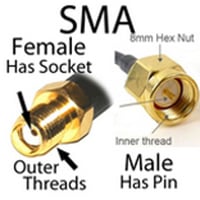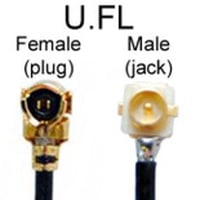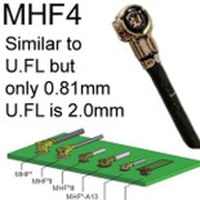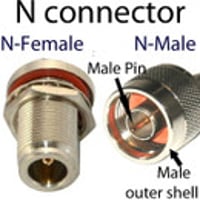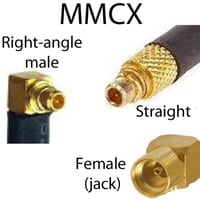RP-SMA Extension Cable: 2FT 26" 28" 30" 32-inch Male to Female
- SKU:
- RSm24iRSf
- Availability:
- In stock
- Weight:
- 0.05 LBS
Data Alliance
RP SMA male-to-female cables from 2FT to 32 inches in Length
- One end has an RP SMA male connector, and the other has an RP SMA female connector with a bulkhead nut and washer for mounting and weatherproofing.
- Other lengths of our RP-SMA extension cables from inches to meters.
- The cable length stated in the length options is between the connectors.
- The connectors are straight RP-SMA-male and straight RP-SMA female connectors with bulkheads.
- Our RP SMA male-to-female cables are built to last. They feature high-quality soldered terminations of RP-SMA connectors with soldering, providing a low-loss connection with discontinuities kept to a minimum. This ensures their durability and performance, making them reliable for wireless devices or networks.
Our RP SMA male-to-female cables are not just about length and thickness. They are double-shielded, low-loss, flexible, and easily bendable, all coax with a black jacket. Double-shielding is a significant factor in their higher quality, translating into lower loss and better performance. With these cables, you can be confident in the reliability and efficiency of your wireless networks.
We offer two options for the thickness of the cable (both are double-shielded):
- The LMR-100-equivalent cable-type is equivalent or better than LMR-100: Has the same or better signal-loss-per-meter and flexibility as LMR100, and less attenuation (signal loss) than RG-174 and RG-178. The higher quality of the cable of this antenna translates into lower loss/better performance. The cable is equivalent to LMR-100 in thickness.
- The LMR-200-equivalent cable-type is equivalent or better than LMR-200: Has the same or better signal-loss-per-meter and flexibility as LMR200, and less attenuation (signal loss) than RG58.
- See comparison of LMR-100 and LMR-200 attenuation (signal loss).

The temperature range for the operational use of these cable assemblies is as follows:
- Cables with 100-series coax: -22 F ~ +185 F (-30 C ~ +85 C)
- Cables with 200-series coax: -31 F ~ +203 F (-35 C ~ +95 C)
RP-SMA female connector includes a bulkhead nut and washer for mounting & waterproofing:
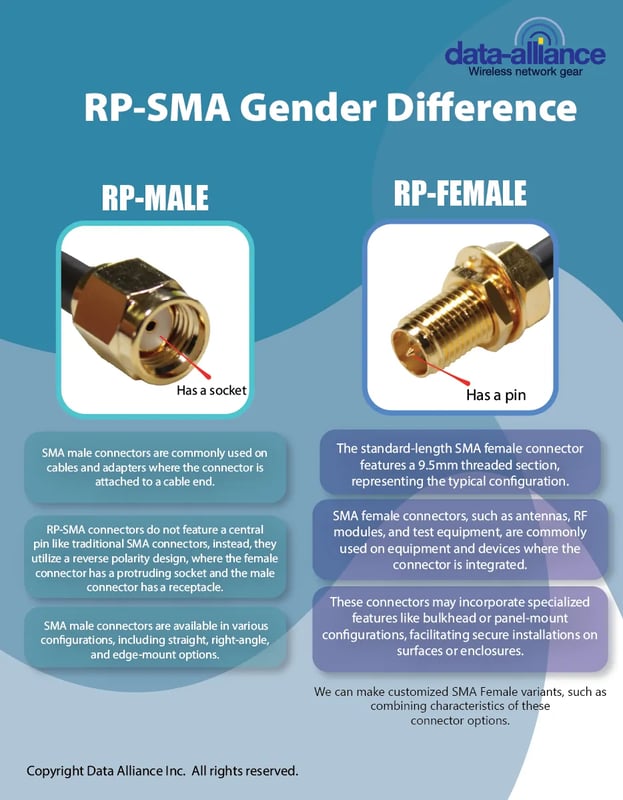
- This can be used to mount the connector (and thus the cable) on the wall of a network enclosure (to weatherproof the cable connection) or on a case, panel, or Printed Circuit Board (PCB).
- Our RP SMA male-to-female cables are designed with weatherproofing in mind. You can seal the hole where the female connector is mounted by placing an O-ring between the enclosure's wall and the bulkhead nut and washer on the female connector. This feature makes them ideal for outdoor use, ensuring your cable connection stays secure even in harsh weather conditions.
- The length of our standard RP-SMA-female connector (threaded part) is 3/8 inches. We have a longer option, 14.5mm, which is available. The longer 14.5mm option has an O-ring embedded in the flange to waterproof the port where the cable enters a network enclosure.
Compatibility with wireless standards & applications:
- All WiFi standards: 2.4GHz and 5GHz applications: Wi-Fi 6, WiFi 6E, 802.11AX, 802.11AC, 802.11N, 802.11G, 802.11B, 802.11A
- Cellular Wireless LTE / 4G, GSM / 3G WiMax, 5G: Data and voice applications
- IoT wireless, automation & Machine to Machine (M2M): Bluetooth, ZigBee, RFID, LoRa, LTE-m, NB-IoT.
- Compatible with all Helium miners used in North America, including Bobcat miners, Sensecap miners, and all other Helium LongFi miners, as are our antenna cables and adapters with RP-SMA-male connectors.
Our RP-SMA extension cables' range of frequency band compatibility (from 0 to 18GHz), consistently low broadband VSWR, and impedance matching to 50 Ohm antennas and cables make them suitable and compliant for all the above applications.
ROHS 3 and REACH: Our antenna cables comply with ROHS 3 and REACH restrictions on lead content, other heavy metals, and toxic materials.
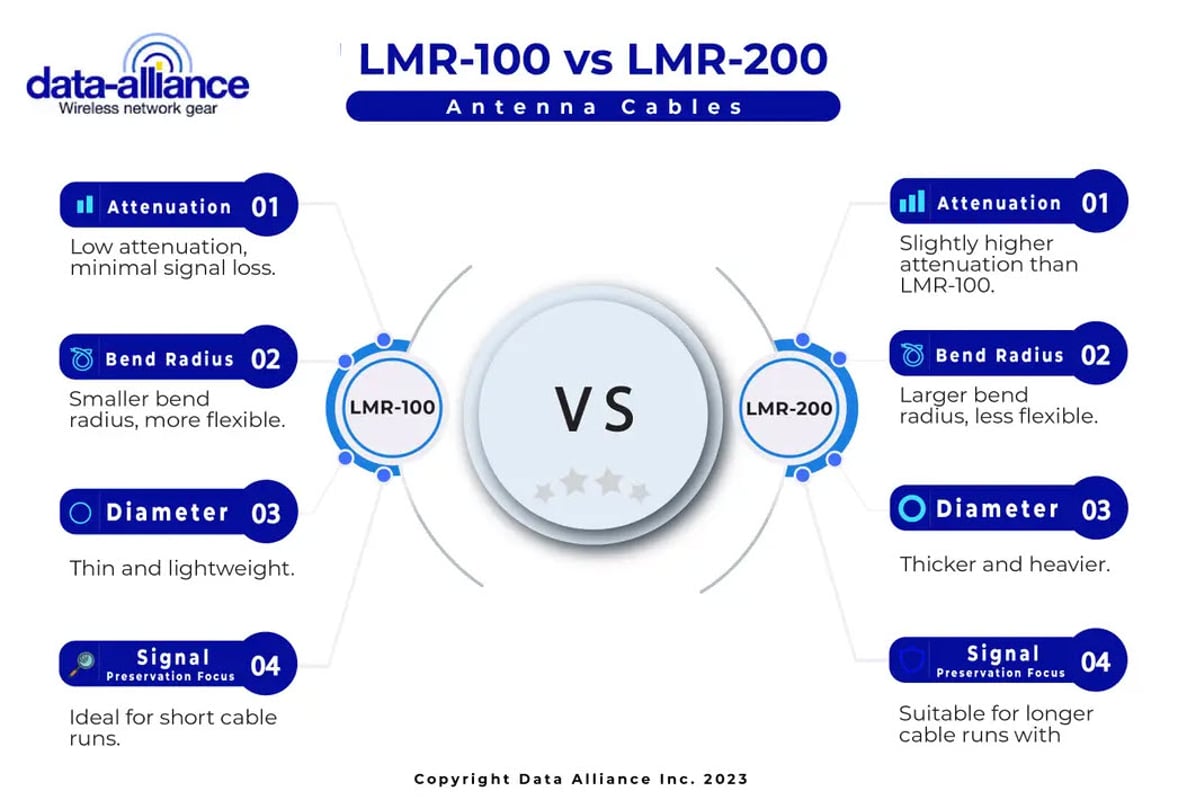
RP-SMA Extension Cables made with LMR-100-equivalent and LMR-200-equiv. coax
Double Shielded for Low Loss of Signal: This cable is ideal for most noisy electrical environments because of its double shielding. An aluminum layer coupled with copper braiding excellently preserves signal strength by significantly attenuating electromagnetic magnetic interference.
Attenuation: Signal loss in the cable
LMR-100 is classed as a low-loss coaxial cable. The following attenuation statistics provide technical insight into this property:
- At 900 MHz: LMR-100 = 0.228 dB/ft.
- At 2400 MHz: LMR-100 = 0.389 dB/ft.
- At 3500 MHz: LMR-100 = 0.48 dB/ft.
- At 5800 MHz: LMR-100: 0.641 dB/ft.
Double Shielded for Low Loss of Signal: This cable is ideal for most noisy electrical environments because of its double shielding. An aluminum layer coupled with copper braiding excellently preserves signal strength by significantly attenuating electromagnetic magnetic interference.
Attenuation: Signal loss in the cable
LMR-100 is classed as a low-loss coaxial cable. The following attenuation statistics provide technical insight into this property:
- At 900 MHz: LMR-100 = 0.228 dB/ft.
- At 2400 MHz: LMR-100 = 0.389 dB/ft.
- At 3500 MHz: LMR-100 = 0.48 dB/ft.
- At 5800 MHz: LMR-100: 0.641 dB/ft.
Products related to RP-SMA:
RELATED PAGES:
- RP-SMA adapters
- RP SMA right-angle adapters and cables
- RPSMA male-to-male antenna cables
Frequently Asked Questions for the RP-SMA extension cables on this page:
-
What is the typical VSWR (Voltage Standing Wave Ratio) for these cables? The typical VSWR for these RP-SMA extension cables is 1.2:1, ensuring minimal signal reflection and loss.
-
What type of dielectric material is used in these cables? These cables use a solid polyethylene dielectric, which provides excellent insulation and maintains signal integrity.
-
What is the typical propagation delay for these cables? The typical propagation delay for LMR100 cables is 1.16 ns/ft, LMR200 is 1.19 ns/ft, and LMR400 is 1.22 ns/ft.
-
Can these cables be used in military applications? Yes, these cables meet MIL-C-17 standards and can be used in military applications requiring reliable RF connections.
-
Do these cables support MIMO (Multiple Input Multiple Output) applications? Yes, these RP-SMA extension cables can be used in MIMO applications to enhance wireless communication performance.
-
What is the maximum tensile strength of these cables? The maximum tensile strength for these cables varies: LMR100 is 30 lbs, LMR200 is 60 lbs, and LMR400 is 150 lbs.
-
Are there any special installation tools required for these cables? No special tools are required; standard RF installation tools are sufficient for these cables.
-
How is the cable performance affected by bending? Excessive bending can increase insertion loss and VSWR, so it’s important to adhere to the minimum bend radius for optimal performance.


